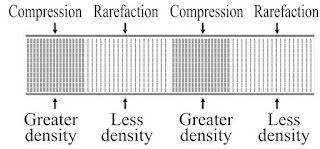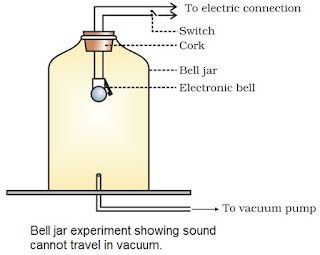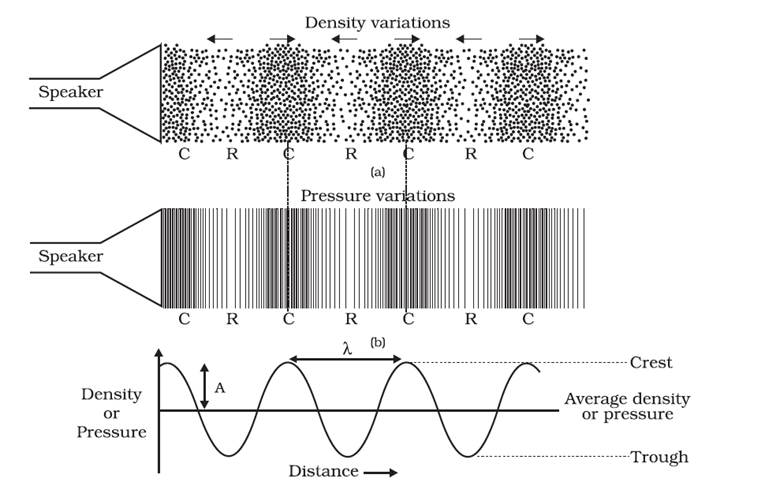- Books Name
- Science Made Easy Science Book
- Publication
- Science Made Easy
- Course
- CBSE Class 9
- Subject
- Science
Propogation of Sound
→ The substance through which sound travels is called a medium.
→ The medium may be solid, liquid or gas.
→ When an object vibrates, then the air particles around it also start vibrating in exactly the same
way and displaced from their stable position.
→ These vibrating air particles exert a force on nearby air particles so they are also displaced from
their rest position and start to vibrate.
→ This process is continued in the medium till sound reaches our ears.
→ The disturbance produced by sound travels through the medium (not the particles of the
medium).
→ Wave is a disturbance which travels through a medium and carries energy.
→ So sound travels in wave form known as mechanical waves.

• When a body vibrates then it compresses the air surrounding it and form a area of high density
called compression (C).
→ Compression is the part of wave in which particles of the medium are closer to one another
forming high pressure.
→ This compression move away from the vibrating body.
• When vibrating body vibrates back a area of low pressure is formed called rarefaction (R).
→ Rarefaction is the area of wave in which particles of the medium are further apart from one
another forming a low pressure or low density area.
→ When body vibrates back and forth, a series of compression and rarefaction is formed in air
resulting in sound wave.
→ Propogation of sound wave is propogation of density change.

Sound needs Medium for Propogation
• Sound waves are mechanical waves.
→ It needs material medium for propogation like air, water, steel etc.
→ It cannot travel in vaccum.
→ An electric bell is suspended in airtight bell jar connected with vacuum pump.
→ So, medium is necessary for propagation of sound.

Experiment to show that sound cannot travel through vacuum
Characteristics of Sound
A sound wave is characterized by three factors:
• Amplitude
• Frequency
• Speed

Sound cannot travel at the same speed in different mediums. The speed of sound in a medium is affected by three things:
• The density of the medium. For instance, speed of sound is the maximum through solids
• The temperature of the medium. As the temperature increases, the sound propagates easily.
• Humidity in the air also affects the travel of sound. As the humidity increases, so does the propagation of sound.
Properties of Sound Waves:
Frequency: Number of oscillations of sound waves is called its frequency. The number of peak and troughs per unit of time will give frequency. It is represented by v (nu) and its SI unit is Hertz (Hz).
Time Period: The time taken to complete one oscillation is called its time period. Its unit is second and is represented by T.
Relation of frequency and time period:
v = 1/T
Amplitude: The magnitude of the maximum disturbance in the medium on either side of the mean value is called the amplitude of the wave. It is usually represented by the letter A. Its unit is meter. Softness or Loudness of Sound: If the amplitude is smaller than the sound will be softer and if it is larger than sound will be louder. Higher amplitude helps the sound wave is travelling faster.
Sonic Booms
• When an object travels in the air with a speed greater than that of the sound, it produces a sound with high energy.
• This energy is loud enough that it can break glasses or damage the buildings. The sound produced is similar to the sound of an explosion or thunderclap.
• These objects exert a large amount of pressure on the air which causes the production of shock waves in the air.
• These shock waves produce extremely large and loud sound waves which are called Sonic booms.
• Speed of light in air = 3 * 108 m/s
• Speed of sound in air = 344 m/s
This clearly states that sound travels a lower speed than that of light in air. This is a reason why at the time of lightening, the light is visible instantly while the sound of the thunder reaches our ears after a few seconds.

 Science Made Easy
Science Made Easy
